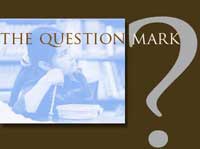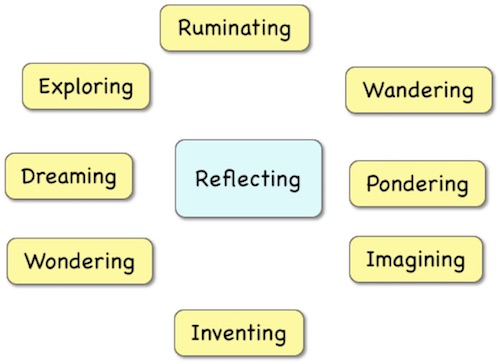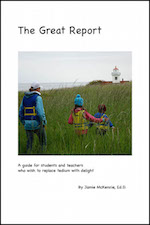| Research Cycle |
Order Jamie's books online with Paypal or a credit card
|
|
|
|
Reflection is central to deep thinking, creative production and understanding. This article explores how reflection contributes to comprehension, synthesis and invention.
All schools should encourage students to be reflective instead of merely reactive, passive
or disengaged. Students should learn and practice incubation, reverie, dreaming and imagining. The Visual Thesaurus provides a large number of activities related to reflecting, as
seen in the diagram reproduced below with permission from Mindmap, Inc. Teachers and schools
often feel pressured to cover a huge amount of curriulum material in ways that sadly leave
little time for meandering, musing or speculating.
Pressure to skim along the surface actually works against deeper understanding and productivity.
Reflecting can be confused with daydreaming and time-wasting rather than being honored as a
legitimate thought process related to productivity.
Otis Redding sings . . .
This is hardly wasting time. It is this kind of sitting that allows the mind to wander, to wonder and to speculate. Sven Birkert calls this process "resonance" in The Gutenberg Elegies:
IncubationWe are looking for something. Perhaps it is a new idea . . . a new product . . . a new way of approaching an old task. Maybe we are trying to understand something as difficult as the impending death of a parent or a friend. We keep churning through the raw material we have gathered in search of new meanings. Making our way toward inspiration and illumination - the "Aha!" phenomenon - usually requires much time and a supportive environment, an incubation period during which the elements of the new idea dance and spin around each other in a mental courtship. This incubation process usually thrives on reverie and musing - mood states within which the subconscious works its best magic. This musing cannot be forced or rushed. But relying upon subconscious incubation will not suffice, in most circumstances, to achieve the most dramatic and significant insights. We must add to our incubation skillful, planned and conscious efforts which might be labelled as "synthesis."
Reverie is the dream state during which incubation, percolation and fermentation may take place. If we hope to see our students producing original, perceptive work, we must teach them the importance of reverie and help them to learn ways to slip into that frame of mind with some frequency and intention. We must help them to see the importance of reducing distractions and interruptions that will prevent them from finding that level of quietude and focus required to spawn deep thoughts. It is important to recognize that the culture does not always view reverie in a positive light, as a thesaurus may list quite a few negative terms related to the term:
Reflecting on a Painting, a Poem, a Photograph or an Essay
When we ask students to look past the surface to consider deeper meanings and possibilities, we are asking them to reflect with due deliberation. Here are some examples that require such thought:
What will it mean to be "well read" in the next decade?We may gather from much richer and broader sources than before, but it will take more than access to information to grasp the meaning of events and make good decisions. Understanding will require both breadth and depth. To find some Truth, we must question, probe, analyze, and synthesize more powerfully than ever before. It is not enough to skim along the surface. This article has shown how reflection is essential. We expect to see our students move from being mere information consumers to information producers.
The Great Report
You can read sample chapters and see the list of chapters by clicking here. Order the print version by clicking below.
|






